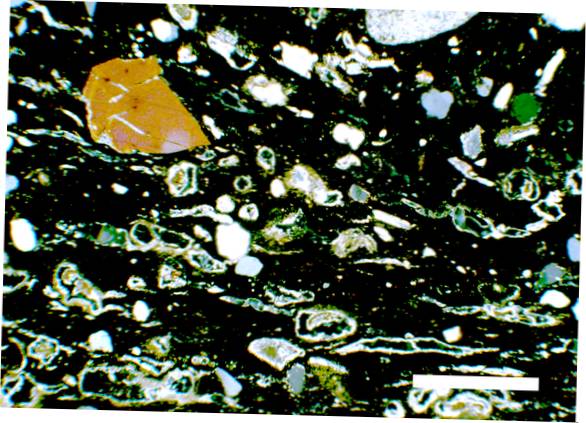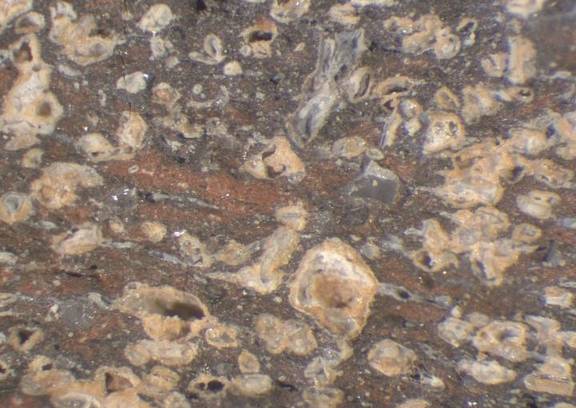| | fabric description | | object data | | archaeometry | | petrography | | |
| fabric type |
MOT-C-1
|
| ware |
Coarse Wares
Plain Ware |
| supposed site of production |
Mozia / Motya |
| certainty of arguments |
archaeometric: certain, archaeological: quite certain |
| visual excamination of fresh break |
colour red, peripheral areas dark greyish brown, texture fine and compact, numerous small to large inclusions: yellowish white, white |
| colour of freshly broken section (munsell) |
weak red 10 R 4/4, peripheral areas dusky red 10 R 3/1 |
| texture of freshly broken surface |
granular |
| hardness |
hard |
| porosity |
2.5%; void form: vughy; void length: 0.04-0.7 |
| inclusions |
25%, length: <0.04-0.8 |
| sorting |
bimodal: poorly-sorted sand in well-sorted silt |
| |
Inclusions
|
|
quartz |
infrequent, rounded, subangular - angular, spherical - subspherical, subelongate, clear, white, 0.04-0.32 |
|
mica |
infrequent, spherical, elongate, angular, white, dark, <0.04-0.04 |
|
calciumcarbonate |
riddled with, well rounded, very spherical - subspherical, elongate, white, yellowish white, orange, <0.04-0.8 |
|
carbonate pseudomorphoses |
riddled with, rounded - subrounded, very spherical - subspherical, subelongate, yellowish white, 0.04-0.8 |
|
black inclusions |
singular, spherical, elongate, black, 0.04-0.06 |
| | fabric description | | object data | | archaeometry | | petrography | | |
| vessel form type |
Jug
Jug Lilybaion BR 5 |
| fragmentation |
profile |
| dimensions |
diameter: 8.2cm (rim) |
| publication |
Quartararo 2012. |
| drawing |
 |
| |
Context Data
|
| site of discovery |
Entella |
| registration code of context |
BR 020 B |
| registration code of object |
BR 020 B |
| | fabric description | | object data | | archaeometry | | petrography | | |
| applied method for sample analysis |
thin section |
| analysis author |
Giuseppe Montana |
| sample taken |
April 2014, by Quatararo, Scuola Normale Superiore di Pisa |
| sample no |
M 187/29 |
| | fabric description | | object data | | archaeometry | | petrography | | |
| sample number |
M 187/29 |
| inventory number |
BR 020 B |
| analysis author |
Giuseppe Montana - Luciana Randazzo |
| email |
giuseppe.montana@unipa.it; luciana.randazzo@unical.it; |
| institution |
University of Palermo - Dipartimento di Scienze della Terra e del Mare (DiSTeM); University of Calabria Dipartimento di Biologia, Ecologia e Scienze della Terra (DiBEST):
|
| |
Inclusions Microstructure
|
| distribution |
moderately homogeneous |
| packing |
medium (10-20%) |
| size |
prevalent:
very fine (0.04-0.1mm), medium (0.2-0.5mm)
|
| roundness |
sub-rounded |
| sorting |
scarce-bimodal |
| maximum grain size |
0.3 mm |
| |
Mineral Inclusions
|
| prevalent |
Monocrystalline Quartz |
| common |
Orthoclase (alteration) |
| sporadic |
Polycrystalline Quartz |
| rare |
Plagioclase, Muscovite |
| |
Rock Fragments
|
| rare |
Sedimentary (Limestone, Sandstone, Chert) |
| |
Newly Formed Phases
|
| common |
secondary calcite |
| |
Other Compositional & Textural Features
|
| frequent |
Microfossils, Micritic Clots |
| quartz grain prevailing roundness |
sub-rounded |
| |
Coating / Slipping
|
| thickness |
|
| conservation status |
|
| |
Texture
|
| homogenity |
moderately homogeneous patchy: common |
| optical activity |
slightly active |
| color |
reddish |
| degree of sintering |
partly sintered |
| |
Porosity
|
| abundance of voids/pores |
medium (10-30%) |
| orientation |
full |
| prevalent |
medium (0.1-1mm), large (>1mm), irregular, vesicular, cast |
| |
Composition
|
| clay composition |
ca-rich |
| |
Interpretation
|
| estimated firing temperature |
low fired |
| modelling of raw clay |
use of wheel |
| refinement of raw clay |
acceptable |
| refinement of temper |
sieved natural sand |
Cite this page as: FACEM - http://facem.at/m-187-29










 production
production
 sampling
sampling






